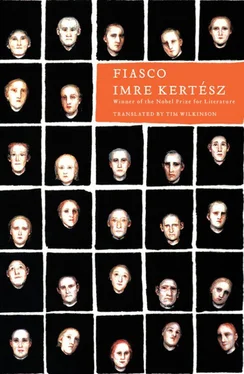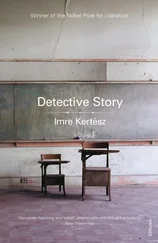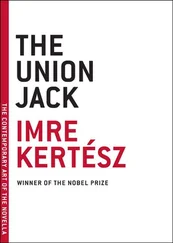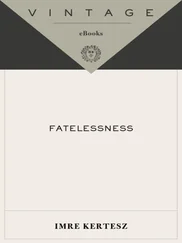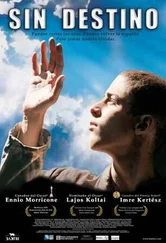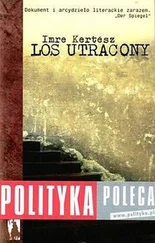Since the furnishings of the flat — the one in which the old boy lived permanently, albeit registered only as a temporary resident — had been kept to the bare necessities from the first, one may confidently hope that those items that we shall pick out below as the most necessary of the bare necessities are at least not unnecessary in the context of our story.
The hallway running in the east-west longitudinal direction (from the entrance), which led, on opening a hammered-glass door bisected at its middle by a painted wooden strip (or, to be more precise, on sidestepping the door, since it was always open in view of the hallway’s airlessness), to the living room, was bounded on its south side by doors to the kitchenette and, to the west of that, the bathroom, with the remaining approx. 30 inches of wall still farther to west providing space for a hall stand (with hat rack).
The northern wall of the hallway was covered along its entire length, from doorframe to doorframe, by a curtain made from an attractive print of manmade fibre, behind which a clever system of racks and shelves strove to efface the memory of two ungainly, disparately-sized wardrobes that had once stood there, long defying the steadfast antipathy of the old boy’s wife, and which, as is allegedly the wont of materials, did not disappear but were merely transformed into said clever system of racks and shelves; indeed a 3 × 3 inch chunk originally from one of the wardrobes (noteworthy for the wax seal that was visible on it) (though the inscription on the wax seal had been rendered almost illegible by a yellowish-white layer of paint from repeated decoration) could still be found, at the time of our story, in one of the old boy’s boxes of papers (though which one, even he didn’t know).
This brings us to the hammered-glass door bisected at its middle by a painted wooden strip on opening which (or, to be more precise, on sidestepping which, since the door was always open in view of the hallway’s airlessness) we can enter the living room.
In the southeast corner of this room (which faced westward on the street side) was a tile stove, and both north and west of the stove, allowing for adequate gaps, were single armchairs (of the Maya II model, constructed from beechwood, nitrocellulose lacquer, HDP straps, foam rubber, furnishing fabric, quality in compliance with the specifications of Hungarian Standards 8976/4/72 and 8977–68, PROTECT FROM DAMP!), between the armchairs (slightly north-west of the stove) a sweepingly curved standard lamp (its shade changing roughly every five years) and, a little farther to the northwest, a tiny, rickety thingamajig, resting on stick legs, which according to its Quality Certificate was a child’s mini-table, 1st-class special ply of 1st-class sawn hardwood, but which in regard to its actual function was more a kind of tiny smoker’s table.
After the armchair to the north of the stove (allowing for an adequate gap) was another gap, and then the hammered-glass door — or to be more accurate, since the door was always open due to hallway’s airlessness — a door-sized aperture, then the hammered-glass leaf of the hammered-glass door, behind which was a gap and, after the gap, in the northeastern corner of the room, the narrower side of one of the sofas, then the corner itself, after which came — now along the northern wall — the longer side of the sofa, space, a low chest of drawers, space, and finally the second sofa, the longer side of which snuggled up to the west wall, stretching north-to-south right under the window where, still more to the south, there was a space, then a table (to be more precise, the table, the only real table in the flat) stretching farther southward, almost to the southwestern corner of the room, the sole obstacle to reaching which was an item of furniture standing in this corner, and which by now should certainly no longer be entirely unfamiliar to the observant reader.
Our job is a good deal easier if we start from the armchair standing to the west of the stove (allowing for an adequate gap) and proceed along the room’s southern wall, because here there is just another gap then, more to the west, a low chest of drawers (an exact copy and pair of the chest of drawers opposite it), with a gap beyond which was the wall protrusion (the purpose of which no one had ever been able to establish), and lastly, in the southwest corner of the room, that hybrid, the bookcase — filing-cabinet centaur (if such a catachresis may be entertained), before which, one splendid, warm, slightly humid but sunny late-summer (early autumnal) morning — which spilled over him and his wider environs like an impenetrable bell jar — the old boy was standing and thinking.
To guard against any definitive fixing of notions which no doubt have already begun to form, our hitherto neutral use of words probably calls for some clarification at this juncture.
Just as the filing cabinet, for example, was not really a filing cabinet, or, to take another example, the old boy’s side street (the Slough of Deceit, as the old boy called it) was not really a side street, the old boy was not really old.
He was old, of course (for why else would we call him the old boy). Still, the old boy was not an old boy for being old; that is to say, he was not an old man (though he was not young either), (for why else would we call him the old boy).
In all probability it would be simplest just to say how old he was (if we were not averse to such exceedingly dubious specifics, changing as they do from year to year, day to day, even minute to minute) (and who knows how many years, days and minutes our story will arch) (or what twists and turns that span may span) (as a result of which we might suddenly find ourselves in a situation where we may no longer be able to vouch for our rash assertions).
So, for want of better, let us fall back on an observation, though in itself it is by no means a particularly original one:
If a person is weighed down by a good half-century, then he either sinks under the burden or somehow withstands it, comes to a standstill (on the hook of time, as it were) (a hook which may, of course, drag and pull him ever further into the wasteland of the other shore, into a shadowy, desiccated abstraction amidst succulent colours and palpable forms), and an enduring moment supervenes which is as if it were not even here, or in other words, tempts us with the deceptive appearance of something still not having been definitively decided (whether or not the rope is strong enough, so to speak) (why wouldn’t it be? nevertheless we are all aware of the circumstance that, for sake of a more secure grip, it gives a little may, in itself, give rise to misconceptions) (above all in the sort of person who has already succeeded in severing the rope once) (but let us not anticipate our tale).
If in what follows we continue to maintain — and we shall — that the old boy was old, obviously we shall have to find another way of justifying this usage (which neither the old boy’s appearance nor even the superior knowledge of a registry office official peeking beneath the surface of things puts in our mouth).
Nothing easier.
For the old boy thought of himself — we can hardly dispute that he had every reason to do so — as old, as someone to whom nothing more could happen, nothing new, whether good or bad (with a proviso for the far from consubstantial chances of the just slightly better or slightly worse) (although this made essentially no difference to the essence), as someone to whom everything had already happened (including what might still happen or might have happened), someone who had outwitted — transiently — his death, lived out — definitively — his life, gained his modest reward for his vices and strict punishment for his virtues, and had long been a permanent figure on that grey list that is kept, who can tell where, and in accordance with what sort of promptings, of those who are excess to headcount; someone who, despite all that, wakes up day after day to the fact that he still exists (and doesn’t find it so unpleasant at that) (as he might, perhaps, have felt) (if he always took everything into consideration) (which he did not do at all).
Читать дальше
